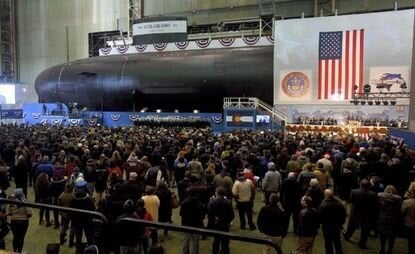![General Dynamics Electric Boat via U.S. Navy [Source: Army Times ]](https://fabbaloo.com/wp-content/uploads/2020/05/image-asset_img_5eb050a2cb9f5.jpg)
Charles Goulding looks at developments in the submarine construction industry where there may be a big opening for 3D printing.
On February 3, 2020, I was privileged to be invited to the General Dynamics Electric Boat Legislative briefing in Groton, Connecticut.
It was presented by Kevin Graney, President of Electric Boat (EB). EB has been awarded the world’s largest shipbuilding contract to build nine Virginia class attack submarines at a contract price totaling US$22B. There is an opportunity for a US$2B added contract if a tenth submarine is added to the contract. EB will also be building the new Columbia class submarines which will replace the current Ohio class.
![Electric Boat's Columbia Class Submarine [Source: USNI ]](https://fabbaloo.com/wp-content/uploads/2020/05/image-asset_img_5eb050a31a7bc.jpg)
This huge long-term contract is a transformational project for the western Connecticut seacoast area and for the contiguous seacoast state of Rhode Island. Electric Boat employment is expected to increase by an estimated 19,000 people at the peak of the contract. Graney particularly emphasized the amount of workforce and apprentice training that needs to take place with this increased number of employees at the time of peak production.
This project is estimated to require the contributions of thousands of additional suppliers. This is the perfect time for the 3D Printing (3DP) industry products and materials suppliers to become qualified suppliers at both the Original Equipment Manufacturer (OEM) and multi-tier supplier levels. The 3DP community should also endeavor to become part of the extensive workforce training process.
Although this is an excellent opportunity for nearby Connecticut and Rhode Island suppliers, they will only comprise a small portion of the suppliers needed to execute this massive project. Connecticut has some exceptional 3DP resources that have been developed in conjunction with United Technologies’ investment in 3DP training and technology as well as the University of Connecticut’s (UConn’s) 3D Printing learning programs.
The US Navy is essentially EB’s only customer and the Navy has had the “Print the Fleet” 3DP initiative for many years. The Navy has been working with UConn on 3D printing technological innovation. A submarine needs to provide a reliable long-term living environment often without access to external mainstream support services for extended periods of time. 3D Printing has been successfully used for submarine repairs but now offers the opportunity to provide a wide range of OEM product components.
R&D tax credits are available to assist EB and its subcontractor’s 3D printing innovation.
![The U.S. Navy's Next Top Missile Submarine [Courtesy of Electric Boat ]](https://fabbaloo.com/wp-content/uploads/2020/05/EB3_img_5eb050a3ab636.jpg)
The Research & Development Tax Credit
Enacted in 1981, the now permanent Federal Research and Development (R&D) Tax Credit allows a credit that typically ranges from 5%-8% of eligible spending for new and improved products and processes. Qualified research must meet the following four criteria:
-
Must be technological in nature
-
Must be a component of the taxpayer’s business
-
Must represent R&D in the experimental sense and generally includes all such costs related to the development or improvement of a product or process
-
Must eliminate uncertainty through a process of experimentation that considers one or more alternatives
Eligible costs include US employee wages, cost of supplies consumed in the R&D process, cost of pre-production testing, US contract research expenses, and certain costs associated with developing a patent.
On December 18, 2015, President Obama signed the PATH Act, making the R&D Tax Credit permanent. Since 2016, the R&D credit can be used to offset Alternative Minimum Tax (AMT) or companies with revenue below $50MM and, startup businesses can obtain up to $250,000 per year in cash rebates that can be applied directly to payroll taxes.
Launching into Action
![Groton, CT Ceremony in 2018 for General Dynamics Electric Boat Attack Submarine [Source: Hartford Courant ]](https://fabbaloo.com/wp-content/uploads/2020/05/image-asset_img_5eb050a3e3b14.jpg)
Electric Boat is commencing a huge long-term submarine building project. As Graney indicated this initiative involves generational change. An interesting example of how another industry is preparing for the EB project comes from Richard H. MacDougall, a senior broker at Breslin Realty the largest East Coast commercial real estate brokerage firm, who also attended the Electric Boat event held at Groton, Connecticut. According to MacDougall:
“We have an expansive 68-acre site in nearby Stonington, Connecticut suitable for Electric Boat and subcontractor/employee housing as well as retail space. The property is right off of the I-95, Exit 92, and is a mere 15-minute drive from Electric Boat’s manufacturing facility. We have invested millions preparing the property, which we hope is used to support the EB submarine project.”
The 3D Printing industry already has a foothold in the relevant U.S. Navy technology and it needs to ramp up its overall contribution as this program sets sail.

